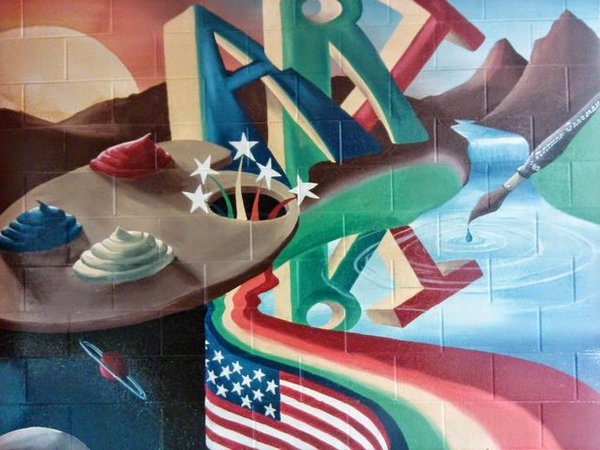Visual Arts
Mary Vacek
Welcome to the Visual Arts Page

www.facebook.com/ArtCCCHS
COFFEE COUNTY CENTRAL HIGH SCHOOL VISUAL ARTS
Our Facebook page is updated regularly with photo s of student work.

Students walk by this mural everyday on their way to the art room. Have you ever noticed how much is actually going on in the mural?
(By Katherine Frey/The Washington Post)
You don’t find school reformers talking much about how we need to train more teachers in the arts, given the current obsession with science, math, technology and engineering (STEM), but here’s a list of skills that young people learn from studying the arts. They serve as a reminder that the arts — while important to study for their intrinsic value — also promote skills seen as important in academic and life success. (That’s why some people talk about changing the current national emphasis on STEM to STEAM.) This was written by Lisa Phillips is an author, blog journalist, arts and leadership educator, speaker and business owner. To learn about Lisa’s book, “The Artistic Edge: 7 Skills Children Need to Succeed in an Increasingly Right Brain World,” click here. This appeared on the ARTSblog, a program of Americans for the Arts.
By Lisa Phillips
1. Creativity – Being able to think on your feet, approach tasks from different perspectives and think ‘outside of the box’ will distinguish your child from others. In an arts program, your child will be asked to recite a monologue in 6 different ways, create a painting that represents a memory, or compose a new rhythm to enhance a piece of music. If children have practice thinking creatively, it will come naturally to them now and in their future career.
2. Confidence – The skills developed through theater, not only train you how to convincingly deliver a message, but also build the confidence you need to take command of the stage. Theater training gives children practice stepping out of their comfort zone and allows them to make mistakes and learn from them in rehearsal. This process gives children the confidence to perform in front of large audiences.
3. Problem Solving – Artistic creations are born through the solving of problems. How do I turn this clay into a sculpture? How do I portray a particular emotion through dance? How will my character react in this situation? Without even realizing it kids that participate in the arts are consistently being challenged to solve problems. All this practice problem solving develops children’s skills in reasoning and understanding. This will help develop important problem-solving skills necessary for success in any career.
4. Perseverance – When a child picks up a violin for the first time, she/he knows that playing Bach right away is not an option; however, when that child practices, learns the skills and techniques and doesn't’t give up, that Bach concerto is that much closer. In an increasingly competitive world, where people are being asked to continually develop new skills, perseverance is essential to achieving success.
5. Focus – The ability to focus is a key skill developed through ensemble work. Keeping a balance between listening and contributing involves a great deal of concentration and focus. It requires each participant to not only think about their role, but how their role contributes to the big picture of what is being created. Recent research has shown that participation in the arts improves children’s abilities to concentrate and focus in other aspects of their lives.
6. Non-Verbal Communication – Through experiences in theater and dance education, children learn to breakdown the mechanics of body language. They experience different ways of moving and how those movements communicate different emotions. They are then coached in performance skills to ensure they are portraying their character effectively to the audience.
7. Receiving Constructive Feedback – Receiving constructive feedback about a performance or visual art piece is a regular part of any arts instruction. Children learn that feedback is part of learning and it is not something to be offended by or to be taken personally. It is something helpful. The goal is the improvement of skills and evaluation is incorporated at every step of the process. Each arts discipline has built in parameters to ensure that critique is a valuable experience and greatly contributes to the success of the final piece.
8. Collaboration – Most arts disciplines are collaborative in nature. Through the arts, children practice working together, sharing responsibility, and compromising with others to accomplish a common goal. When a child has a part to play in a music ensemble, or a theater or dance production, they begin to understand that their contribution is necessary for the success of the group. Through these experiences children gain confidence and start to learn that their contributions have value even if they don’t have the biggest role.
9. Dedication – When kids get to practice following through with artistic endeavors that result in a finished product or performance, they learn to associate dedication with a feeling of accomplishment. They practice developing healthy work habits of being on time for rehearsals and performances, respecting the contributions of others, and putting effort into the success of the final piece. In the performing arts, the reward for dedication is the warm feeling of an audience’s applause that comes rushing over you, making all your efforts worthwhile.
10. Accountability – When children practice creating something collaboratively they get used to the idea that their actions affect other people. They learn that when they are not prepared or on-time, that other people suffer. Through the arts, children also learn that it is important to admit that you made a mistake and take responsibility for it. Because mistakes are a regular part of the process of learning in the arts, children begin to see that mistakes happen. We acknowledge them, learn from them and move on.

